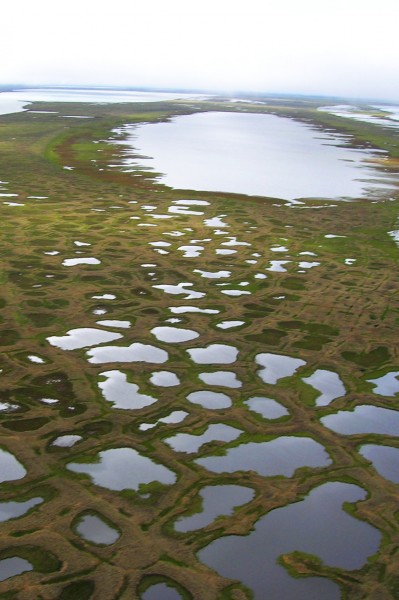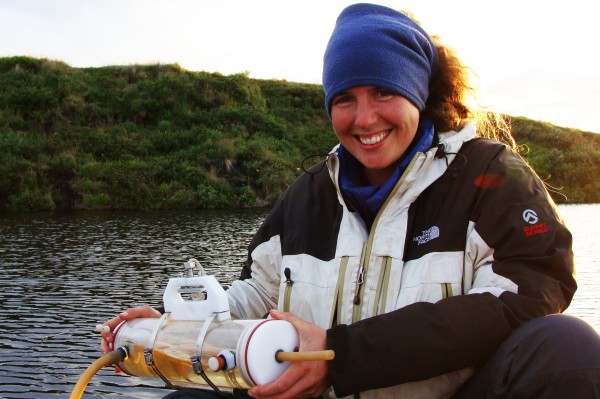Study: Climate-cooling arctic lakes soak up greenhouse gases
July 16, 2014

Marmian Grimes
907-474-7902
7/16/14
New University of Alaska Fairbanks research indicates that arctic thermokarst lakes stabilize climate change by storing more greenhouse gases than they emit into the atmosphere.
Countering a widely held view that thawing permafrost accelerates atmospheric warming, a study published this week in the scientific journal Nature suggests arctic thermokarst lakes are "net climate coolers" when observed over longer, millennial, time scales.
“Until now, we’ve only thought of thermokarst lakes as positive contributors to climate warming,” says lead researcher Katey Walter Anthony, associate research professor at the UAF Institute of Northern Engineering. “It is true that they do warm climate by strong methane emissions when they first form, but on a longer-term scale, they switch to become climate coolers because they ultimately soak up more carbon from the atmosphere than they ever release.”
Found in the Arctic and cold mountain regions, thermokarst lakes occur as permafrost thaws and creates surface depressions that fill with melted fresh water, converting what was previously frozen land into lakes. Researchers observed that roughly 5,000 years ago, thermokarst lakes in ice-rich regions of northern Siberia and Alaska began cooling, instead of warming the atmosphere.
“While methane and carbon dioxide emissions following thaw lead to immediate radiative warming,” the authors write, “carbon uptake in peat-rich sediments occurs over millennial time scales.”

Using published data from the circumpolar arctic, their own new field observations of Siberian permafrost and thermokarsts, radiocarbon dating, atmospheric modeling, and spatial analyses, the research team studied how thawing permafrost is affecting climate change and greenhouse gas emissions.
Researchers found that “thermokarst basins switched from a net radiative warming to a net cooling climate effect about 5,000 years ago,” according to their article, published online today. They found that high rates of carbon accumulation in lake sediments were stimulated by several factors, including “thermokarst erosion and deposition of terrestrial organic matter, nutrient release from thawing permafrost that stimulated lake productivity, and by slow decomposition in cold, anoxic lake bottoms.”
“These lakes are being fertilized by thawing yedoma permafrost,” explained co-author Miriam Jones, research geologist for the U.S. Geological Survey. Yedoma is a type of permafrost that is rich in organic material. “So mosses and other plants flourish in these lakes, leading to carbon uptake rates that are among the highest in the world, even compared to carbon-rich peatlands.”

The study also revealed another major factor of this process: Researchers found that when the lakes drain, previously thawed organic-rich lake sediments refreeze. The new permafrost formation then stores a large amount of carbon processed in and under thermokarst lakes, as well as the peat that formed after lake drainage. Researchers note that the new carbon storage is not forever, since future warming will likely start rethawing some of the permafrost and release some of the carbon in it via microbial decomposition.
Because roughly 30 percent of global permafrost carbon is concentrated within 7 percent of the permafrost region in Alaska, Canada and Siberia, this study’s findings also renew scientific interest in how carbon uptake by thermokarst lakes offsets greenhouse gas emissions. Through its data collection, the study expanded the circumpolar peat carbon pool estimate for permafrost regions by more than 50 percent.
This international collaboration has received funding or support from the Alfred Wegener Institute, National Science Foundation, University of Alaska Fairbanks and U.S. Geological Survey. It also included researchers from the Far-East Branch, Russian Academy of Sciences; University of Minnesota; University of Florida; Max Planck Institute for Terrestrial Microbiology; and University of New Hampshire.
RESOURCES FOR JOURNALISTS:
Download the paper
Download photo captions and credits
Access additional photos from the Alfred Wegener Institute.
Download the briefing audioconference recording.
AUDIOCONFERENCE INFORMATION:
For journalists in the U.S. and Canada, the number is 800-893-8850. The PIN is 1211736.
International media can access the audioconference by calling +011-503-295-8000. Enter 800-893-8850 and the PIN: 1211736.
ADDITIONAL CONTACTS:
Katey Walter Anthony
Assistant research professor
Institute of Northern Engineering
University of Alaska Fairbanks
Office: 907-474-6095
Email: kmwalteranthony@alaska.edu
Miriam Jones
Research Geologist
United States Geological Survey
Office: 703-648-6936
Email: miriamjones@usgs.gov
Guido Grosse
Geoscientist
Division of Geosciences and Periglacial Research
Alfred Wegener Institute
Phone: +49-331-288-2150
Email: guido.grosse@awi.de
F. Stuart Chapin
Professor emeritus
Institute of Arctic Biology
University of Alaska Fairbanks
Office: 907-474-7922
Email: terry.chapin@alaska.edu
MG/7-16-14/010-15


